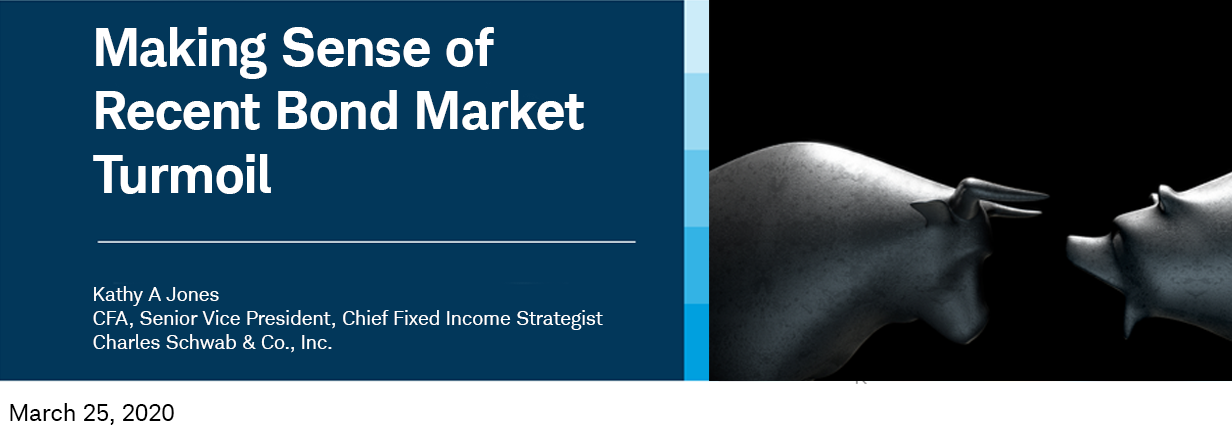
View recent market volatility updates from Schwab
The recent volatility in the bond market has been unprecedented. Over the course of just two weeks, long-term Treasury yields fell one full percentage point to record lows, while yields for nearly every other type of bond spiked sharply higher.
As cities and states moved to close nonessential businesses to slow the spread of COVID-19, the risk of a sudden, deep economic downturn became apparent. In reaction, investors sold bonds with any type of risk attached to them, and rushed to cash for safety. Consequently, short-term Treasury bill yields fell below zero, while the 10-year Treasury yield traded in the widest one-week range in more than a decade, touching all-time lows before rebounding sharply.
The 10-year Treasury yield swung widely in March

Source: Bloomberg. Daily data as of 03/20/2020.
The Fed steps in
The Federal Reserve has taken equally unprecedented steps to try to calm markets and restore order, and has pledged to do more if necessary. Reopening its playbook from the financial crisis of 2008-2009, the Fed has lowered interest rates, indicated it would return to buying bonds in “unlimited quantities” for its balance sheet, eased some regulatory requirements for banks, and created new vehicles to target the areas that are most stressed, including the corporate and municipal bond markets.
The combination of these moves—interest rate policy, forward guidance, large-scale asset purchases and regulatory relief—is designed to free up money that has become clogged in the financial system and make it easier for businesses, households and communities under duress to access funds they need to tide them over through the crisis.
While the Fed has done a lot already, we believe it could do more if needed. However, Congress has agreed to a fiscal stimulus package that can supplement the Fed’s actions to support the economy by quickly getting funds directly into the hands of households and businesses that need it. Lawmakers are expected to vote on the package in coming days.
Why is this happening?
1. The coronavirus crisis has upended interest rate and credit risk expectations.
Typically, fixed income markets are driven by two primary factors: prospects for interest rate policy set by the Federal Reserve, which reflects prospects for economic growth and inflation; and credit risk—the risk that the issuer will default by not making scheduled interest or principle payments.
The coronavirus has upended expectations for both of these factors. The Federal Reserve has lowered its base lending rate, the federal funds rate, to near zero, but fears about credit risk have sent yields on other types of bonds sharply higher. That difference—between Treasury yields and those of corporate or municipal bonds of comparable maturity—is used as a way to measure the riskiness of a bond. As Treasuries are considered risk-free, the relative yield on other bonds should reflect the riskiness of the bond.
Prior to the coronavirus becoming a widespread risk to the economy, the yield differences were very low. Investor demand for yield was so strong that the yield premium required for holding the riskiest bonds declined to near record lows. The low starting point set the stage for the sharp surge higher as prospects for the economy changed.
2. Market liquidity has dried up.
There is also a third factor that contributed to the volatility in the bond market—liquidity, or rather the lack of liquidity. Liquidity is a word that can have different meanings in finance. In this case, we are using it to mean the ability of an investor to get a reasonable price in a reasonable time frame when buying or selling a security.
In the bond market, the degree of liquidity can range widely between asset classes. Short-term Treasuries tend to be the most liquid. An investor can usually buy and sell these securities in large quantities with very little difference between the asking price and the bid price at any point in time. Banks and large financial institutions tend to be the biggest buyers and sellers. In the corporate bond market, investment-grade bonds tend to have more liquidity than high-yield bonds, but less than Treasuries. Municipal bonds tend to have less than corporate bonds.
In times of market stress, investors tend to move from the least-liquid markets into short-term Treasuries for their safety and liquidity. In the rush to sell their holdings to raise cash, the least-liquid markets will tend to see the biggest price moves. That has been the case over the past few weeks. We believe lack of liquidity has exacerbated the price drops in many fixed income markets.
A mixed impact
Here’s how the various fixed income asset classes have performed relative to Treasuries.
Investment-grade corporate bonds: For corporate bonds, those with ratings of BBB or higher, the yield spread relative to Treasuries leaped to the highest reading since the financial crisis in 2008.
Investment-grade spreads have reached highs not seen since the Great Recession

Source: Bloomberg, using daily data as of 03/19/2020. Option-adjusted spreads (OAS) are quoted as a fixed spread, or differential, over U.S. Treasury issues. OAS is a method used in calculating the relative value of a fixed income security containing an embedded option, such as a borrower's option to prepay a loan.
Past performance is no guarantee of future results.
As companies come to grips with the economic downturn, prospects for corporate earnings and cash flow have deteriorated, leading markets to demand more yield from these issuers’ bonds.
High-yield corporate bonds: Not surprisingly, the move was just as dramatic for high-yield (or “junk”) bonds (those with ratings below investment grade) although they haven’t exceeded the highs seen in the financial crisis.
High-yield spreads rose to the highest level since the 2008-2009 financial crisis

Source: Bloomberg, using daily data as of 03/20/2020. Option-adjusted spreads (OAS) are quoted as a fixed spread, or differential, over U.S. Treasury issues. OAS is a method used in calculating the relative value of a fixed income security containing an embedded option, such as a borrower's option to prepay a loan.
Past performance is no guarantee of future results.
Because high-yield bond issuers tend to have the most debt-laden balance sheets, investors have been quick to reprice the risk of rising defaults.
Municipal bonds: The rush away from risk was even more evident in the municipal bond market, although it is often somewhat less sensitive to near-term economic risks. In fact, the muni bond market was one of the hardest hit of the fixed income asset classes. Investors pulled large amounts of money out of muni bond mutual funds and exchange-traded funds (ETFs), reversing a long trend of inflows.
Muni ETFs and mutual fund flows have turned negative

Source: Investment Company Institute (ICI), as of 3/25/2020. Data is for estimated weekly fund flows.
Note: Weekly fund flows are estimates based on reporting covering more than 98% of mutual fund and ETF assets. Mutual fund data represent net new cash flow, which is new sales minus redemptions combined with net exchanges, while ETF data represent net issuance, which is gross issuance less gross redemptions. Data for mutual funds that invest primarily in other mutual funds and ETFs that invest primarily in other ETFs were excluded from the series.
As investors rushed to exit these investments all at once, the ratio of municipal bond yields to Treasury yields (referred to as the “municipals over bonds” or MOB spread) reached record highs, exceeding the 2008 peak. While the rise in yields may reflect concerns about the financial strain on state and local governments due to the drop in tax revenues from businesses closing and unemployment rising, we believe much of it was due to the lack of liquidity in the underlying market. The outflow from funds likely forced some managers to sell into the declining market to meet redemptions.
The 10-year MOB spread has surged above its prior high

Source: Bloomberg, as of 03/20/2020.
What investors can do
For some investors, the best course of action may be to do nothing. If you have a diversified portfolio that is designed to last through market ups and downs, you may be best off waiting out the storm. For those who are upset by the volatility, there are some steps that would make sense:
- Reduce risk. If you are very concerned about the recent volatility and/or need cash for near-term obligations, then it may be time to reduce exposure to risk assets. There may still be time to harvest some gains and build up cash.
- Preserve capital. This selloff won’t last forever, but it could last a while longer. Having some safe capital on hand to ride out an extended downturn – perhaps as much as a few years - is important. In a recession, it can take 3 to 4 years for the stock market to get back to its previous high.
- Aim for a high level of diversification. Asset classes have been selling off in concert, but at some point there will be differentiation by credit quality. Having some low volatility assets and revamping a portfolio to improve diversification can help reduce volatility.
- Aim for more liquidity and less leverage. The price moves in more liquid securities should be smaller when markets are volatile, and leverage will tend to amplify price moves.
On the other hand, some investors are willing and able to take on more risk. These investors might consider the following:
- Look for tactical opportunities—cautiously. As markets sell off, opportunities are starting to pop up. For investors with the appetite and capacity for risk, this may be a good time to start adding some investments at relatively low prices. However, it’s important to size positions according to risk, time horizon and liquidity. With markets so volatile, adding to risk assets should be done in small increments. Investors should only take as much risk as they can handle in volatile markets, and be prepared to hold them for at least a few years.
- High-grade municipal bonds may make sense for opportunistic investors. While slowing economic growth likely will weigh on municipalities by reducing tax revenues and increasing outlays, many state and local governments are in good shape and have the ability to weather the storm.
- Preferred securities may be worth a look. We see the potential for preferred securities to rebound once the market regains its risk appetite. These are aggressive income investments with exposure to the credit risk of bank and finance companies, as well as long durations, and they’re not appropriate for all investors. However, yields have moved up and prices have fallen to a point where there may be some opportunities for investors with the risk capacity to find securities that deliver higher income.








